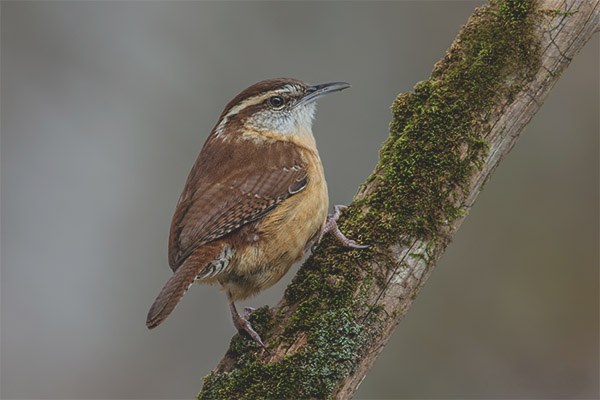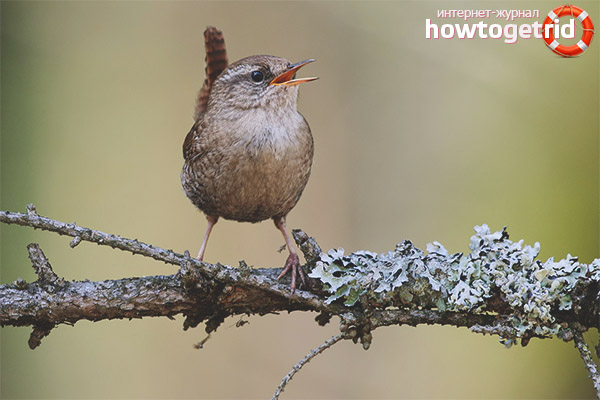The content of the article
The wren is also called the sub-root, and also the hazelnut. It is the only individual belonging to the wren family. If you translate the name of a bird, you can understand it as “an individual living in a cave.” Such name feathered friends received because of their nesting method. They prefer to make a dense housing in the format of the ball, which looks similar to the cave. Let's not look ahead, consider the features of the species in more detail.
Description
- The fact that individuals are called hazel and sub-rooted, we have already figured out. They are also familiar to people under the name zavornivost. Listed species have been given names due to their external data.
- A wren is a small bird that can grow up to 12 cm in size. The body format is round, short-necked, round-headed. A special feature of the bird is its tail up.
- The color of the feathers is brownish with chestnut splashes. The plumage is fluffy and soft, light in the abdominal region and dark on the back. Beak thin, bent down, elongated.
- The individuals of this family are similar to fluffy balls. They are distinguished by their loud voice and sonorous singing, as well as the speed of movement. They can fly fast and move over land. In their size, birds are comparable to sparrows. With a body length of 10 cm. Their weight is about 12 grams.
Habitat
- The family of wrens has its own homeland, it is considered North America. Experts have concluded that it was from here that the birds moved to Eurasia.
- Also, these individuals are found in Asian countries, they are suitable climatic conditions. The largest population is certainly in North America, but individuals also live in Europe.
- Birds of this family prefer to live in a mixed or coniferous forest. They like to have lakes, rivers and other water sources nearby.
- Hazel try to fly around the side of the desert areas, but they are often met in the park areas next to people.Birds also live in a mountainous area at a decent height from the sea.
Nutrition
- If we consider the diet of the birds discussed, they like food of animal origin. The menu everyday includes a variety of bugs, spiders, insect larvae, grasshoppers and other pests.
- When there is no opportunity to eat animal food, birds are introduced into the plant food. Lying on berries such as elderberry, blueberry. Be sure to eat seeds and cobs.
- Since the roots are trying to keep close to water sources, they can always get food. They catch tadpoles aground, absorb fish.
Lifestyle
- Wrens love to soar in the air, getting from this true pleasure. They are mobile, active, in a short time they fly a long distance, they do not hover in the sky, but above the ground. They are quirky and agile, crawl through different cracks.
- Characteristic of this variety is considered to be a bright and sonorous voice, the songs are beautiful and sonorous, similar to the nightingale or canary. Individuals of the male gender through the songs conquer and protect their territory from strangers.Birds do not sing seasonally, but year-round. May stop action only in the middle of summer and until the beginning of autumn (molt).
- If the individual notices the danger, then it will try to hide in the thick grass or on the ground. Birds prefer to lead a single lifestyle. In some cases, the birds are divided into pairs or live in small groups. Most often this occurs in a safe area protected by other birds.
- At night, individuals often gather in a flock, in which there are no more than 10 birds. Thus, the birds spend the night in the thick grass or on the ground. They form a circle in which they place their heads towards the center. Thus, they retain more heat.
- As for food, the basis of their diet in most cases includes beetles, insects, crustaceans, etc. If for some reason they cannot get food of animal origin, birds start to feast on seeds, berries and algae. Birds are looking for food on the ground or shallow water.
Breeding
- After wintering, wrens return to their usual habitats. The migration period falls in the middle of spring.Many factors depend on the specific region of their habitat. Most often the males arrive first to the nesting sites.
- Individuals of the male try to break their territory into personal areas. Only after that they start building nests. This behavior is not typical for most species of birds. In addition, the personal area of the wren should have several criteria.
- On the personal territory of the bird, must be present thick grass and thickets. Also required to have a water source. Thanks to all this, birds can hide from pests and calmly provide their families with everything they need.
- One male builds about 6 nests, maybe more. In this case, the female will choose the chosen one who has the most housing. Often males build nests on the ground or a small hill. Also dwellings can be found between the roots and on the stumps.
- Birds build nests from leaves, twigs, moss, straw and grass. Individuals try to use almost everything that they can carry in their beak. At the same time, all dwellings are only half completed. After the female chooses a suitable place for her, the male finishes her work.
- During the nesting season, the couple may have 2 broods. There are up to 6 white eggs in a clutch at a time. At the same time on the shell can be observed red blotches. The female incubates the future offspring of half a month. After the birth of a young stock, both adults are cared for.
Wrens are quite interesting individuals. Indians have a saying that such birds, in spite of their small size, produce too much noise. Separately, it is worth noting that individuals often destroy eggs of other birds.
Video: Wren (Troglodytes troglodytes)












To send